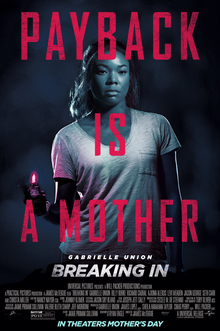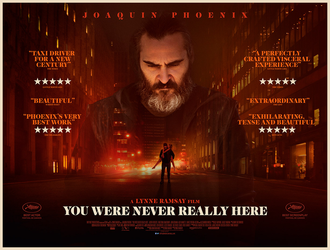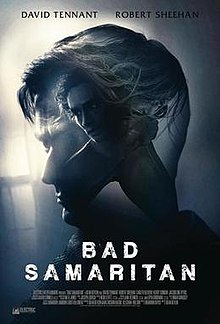| Breaking In | |
|---|---|
 |
by Peter J. O’Connell
Breaking In. Released: May 11, 2018. Runtime: 88 mins. MPAA Rating: PG-13 for violence, menace, bloody images, sexual references, and briefstrong language.
Director James McTeigue’s Breaking Indraws together tropes from two recent films: an African-American mother’s fierce struggle to rescue her young (2017’s Kidnap, starring Halle Berry) and the desperate attempt
to get into a house despite its high-tech security system so as to get a victim out (the currently playing Bad Samaritan).
The African-American mother in Breaking Inis Shaun Russell (Gabrielle Union), and her children are the tween Jasmine (Ajiona Alexus) and her younger brother, Glover (Seth Carr). The movie begins with Shaun’s father, Isaac (Damien Leake), jogging. A delivery truck deliberately runs into him. The driver gets out and with a booted foot crushes Isaac’s skull as he lies in the street.
Having gotten our attention with this opening, the film then has, sometime later, Shaun and her kids drive out to Isaac’s isolated house, which has an elaborate security system, to wind up his affairs. While Shaun is outside the house for a time, four thugs sneak into it and take Jasmine and Glover hostage. One of the thugs, Peter (Mark Furze), attacks Shaun but gets skewered with a wine glass and knocked out against a rock for his trouble.
Peter is out of the picture—for a while—but the other three thugs are still inside menacing the kids and keeping Shaun outside. Over the intercom, Eddie (Billy Burke), leader of the bad guys, explains to Shaun, in a somewhat world-weary manner, that there is $4 million in ill-gotten gains that Isaac has stored in a safe somewhere in the house. Peter knows how to open the safe, but neither he nor any of the other thugs knows the safe’s location.
Cell phones are dysfunctional, and events seem at a stalemate. Eddie tells Shaun: “You are a mother alone at the mercy of strangers. Your greatest weakness is locked in this house with us.” Will Shaun cooperate with Eddie in order to save her kids?
This possibility is vitiated by an extreme act by one of the criminals, the intense, hatchet-faced Duncan (Richard Cabral). Duncan’s act turns the fear that Shaun has into desperation to save her kids, which she sets out trying to do with great ingenuity—and even greater violence. The film even gives Shaun an appropriately Eastwoodian line: “You broke into the wrong house!”
Shaun’s courage acts as an inspiration for the kids, who join in the struggle. It’s a good thing that they do, for—and this will make Nutmeggers who remember the Cheshire home invasion queasy—the thugs are threatening them with rape and immolation.
Breaking Inmoves briskly through its running time, mixing clichéd material with fresh material, strong performances (Union, Cabral) with insufficiently intense ones (Burke), familiar cinematic techniques with imaginative ones. The film provides little in the way of enlightenment but more than a modicum of exciting entertainment. If you didn’t see it on Mother’s Day weekend, when it was released, at least try and see it before Father’s Day. In its own way, it is an affirmation of family values!
“Footnote” to the film:Breaking Inhas been called “a Panic Roomin reverse.” Panic Roomwas a 2002 film in which Jodie Foster played a mother who stays with her child in a sealed, locked room after thugs take over her house.











